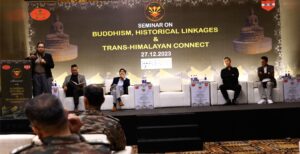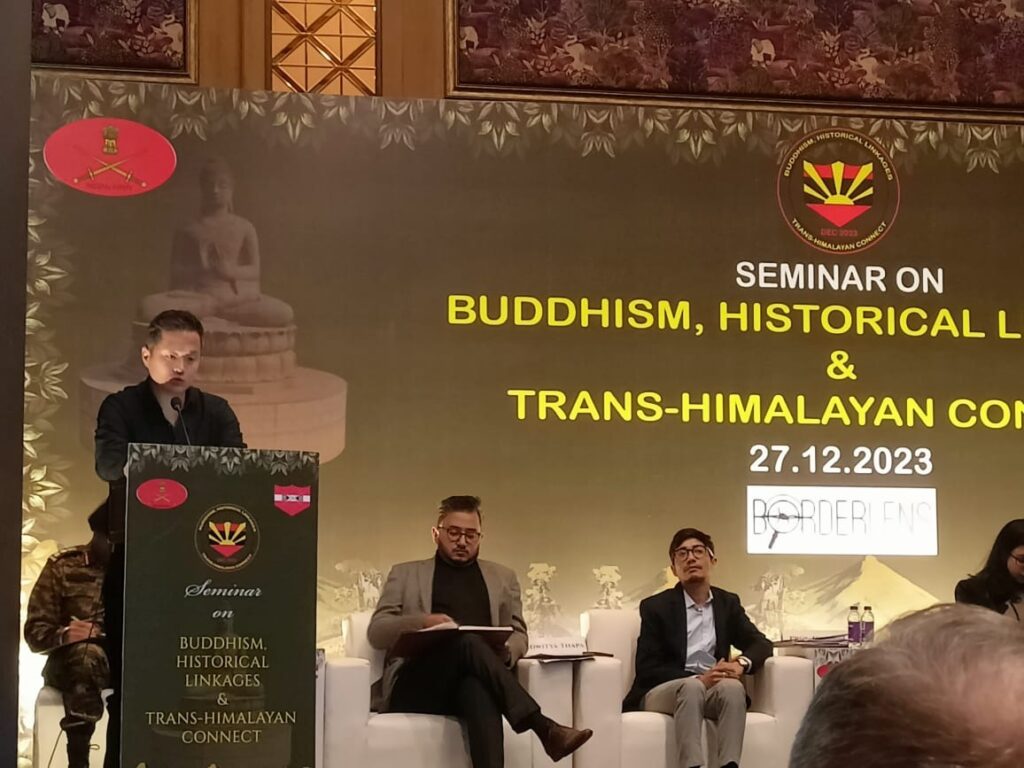Civilisation is a celebration of life, history, cultures, traditions, connectivity, and the migration of people across geographies. Most importantly, it embodies the spread of humanity and the preservation of cultures and history across man-made lines drawn on our maps at different ponts of time in history. India’s civilisation is one such story of celebration, retold through different mediums of communication and continues to resonate across various formats.
A similar story of civilisation spread across the eastern Himalayas connecting Nepal, India, Bhutan, Tibet and northern Myanmar unfolded recently at a gathering of scholars, writers, researchers, civil society and military personnel at Siliguri on December 27. The theme of the event focused on ‘Buddhism, historical linkages and the Trans-Himalayan Connect’ – a one-day multi-stakeholders gathering put together by The Borderlens and the Trishakti Corps of the Indian army under the aegis of the Eastern Command.

Narratives of Buddhist heritage in the Eastern Himalayas
From the story of the Tantric Buddhist Guru Padmasambhavawho in lore and legend, has been a major attraction connecting the Buddhists of the high Himalayas, their land Monyul, which extends southward from the Tibetan plateau and across the crests of the Himalayan Mountain ranges into India, to the stories of Bara Kagyu master Drubthob KonchogGyaltsen and the socio-cultural relations between India and Nepal, it was a perfect occasion to revisit our history, culture, heritage and ancient pilgrimage sites across the Himalayas and beyond.
The one common phrase which resonated across the room was that “the folklore, beliefs and the history connected to Buddhist heritage sites across the Eastern Himalayas need to be told in ways that can help connect a bigger audience both within our own geographical realms and across the outside world.” Scholars, intellectuals, writers, civil society, strategic studies and security experts and others who attended the one day conclave made a huge difference to the spread of this consciousness, especially in a highly strategic area such as the Siliguri Corridor.
The importance of understanding of syncretisation in the spread and preservation of our cultures in the Himalayas overcoming the challenges at different points of time in history was brought to the fore by the speakers. The backdrop to this was the spread of Tibetan Buddhism and its relevance to the various aspects of life in the Himalayas.
Tibetan Buddhism as described by Prof Jigme Yeshe Lama of the University of Kolkata, forms “the common thread” stitching what has been termed as ‘cultural Tibet’ that includes major portions of the Himalayas stretching from Ladakh, Lahoul-Spiti, Nepal, Darjeeling Hills in India’s West Bengal, Sikkim, Bhutan and Tawang in India’s northeastern state of Arunachal Pradesh. The form of Buddhism in Tibet and the Himalayas is Vajrayana or tantric Buddhism, that came to these regions in the 8th century AD and spread into four major schools of Nyingma, Kagyu, Sakya and Geluk. These are further divided into sub-schools, who have monasteries and communities spread across Tibet and the Himalayas.
The essence of the various facets of Tibetan Buddhism and its relevance can be found all over the Himalayas reminding us of our civilisational connect stretching across Bhutan to Tibet and beyond. For example stories of places like the ChumiGyatse, which is one of the many Buddhist heritage sites that dots the mountainous terrains of Arunachal Pradesh on India’s eastern frontier are examples of such heritages which needs to told to the outside world.
The Monpas, who mostly live in Arunachal Pradesh in the Tawang and West Kameng districts, and also some to the north in Tibet, in a contiguous belt in the upper Himalayas, believe that folklore and beliefs connected to Buddhist heritage sites like the Chumi Gyatse too feel such stories would help us reconnect with our histories and how Vajrayana Buddhism blended.

Himalayan Shifts: Navigating change through ethnographic research
The territorial connections between India and its neighbours in the eastern Himalayas, be it through culture, religion, history or even strategic concerns, has sustained through ages.
While, the territorial connections help to foster bi-lateral relations it also serves as a mutually beneficial constellation for security and economic development between India, Bhutan, Nepal, Bangladesh and other countries in the region.
This has helped to build a comprehensive understanding of each other’s needs, be it the developmental assistance or the strengthening of its common cultures, religions, people-to-people connect or addressing the regional security concerns.
The event is part of a process of reflection of some of the much-needed and plausible popular discourses which highlights our history, culture, heritage and ancient pilgrimage sites across the Himalayas and beyond. The aim is to ensure that this transcends discussions and documentation within a certain group, reaching a wider audience, especially people who inhabit such rich and vast expanse of geography.
“Besides, this we want to be able to add value to the efforts of the scholarly community, historians, writers and researchers by continuing to revisit such stories,’ said Nayanjyoti Bhuyana senior representative of the The Borderlens. In iteration such story-telling which we promote are meant to make people well-informed about a part of history which has possibly been not been narrated and told in a manner that it can make the process more inclusive and engaging.
Beyond Borders: Rethinking Eastern relationships in the Himalayas
The Himalayas form an important part of this initiative which has been supported by the Indian Army and major governmental institutions and universities alike. The Himalayas provide vast scope for research, particularly ethnographic research which is believed to promote development that are viable in the Himalayan ecosystem and at the same time foster layers of democratisation.
In light of technological advancements and expanded communication on the Himalayas, migration takes centerstage. Prof. Binayak Sundas of the University of North Bengal aptly notes, “Migration is about the Himalayas, not settlers,” emphasising the impact of the region on questions of identity, migrants, and refugees. This observation holds broader significance, urging us to transcend Western concepts of acceptance and rejection that often hinder a nuanced understanding of these complex issues. “We use western concepts, western methods, and ideas, to make things high sounding, to understand eastern relationships. In International Relations, there is extensive use of eastern ideas and that has been happening since “time immemorial,” adds Prof. Sundas.
Meanwhile, the seminar also featured elements of both goodwill and progress as well as challenges in India’s relations with its neighbours. Prof. Aditya Thapa of the University of North Bengal, touched upton the growing resentment towards India in Nepal, and its pivot to China, which he opined reflected the shifting geopolitical dynamics whereby imaginations emerge, challenging the conventional nation-state concept.
The speakers also delved into the concept of “timespace” to drive home the message of the historical bonding which exemplifies the India and Nepal relations. “The intrinsic Himalayan nature of space-times becomes apparent, where border points and borders themselves represent distinct space-times. The movement of people across these borders is not merely physical but involves an imaginative connection,” observed Prof. Sundas.
Other speakers who were presented their views included Tenzing Longsel Barphungpa Assistant Professor in the Department of Buddhist & Tibetan Studies, Namgyal Institute of Tibetology, Sikkim and Prof. Dickey Lama Assistant Professor of Political Science in Women’s College, Kolkata. The General Officer Commanding (GOC), 33 Corps, Lt Gen VPS Kaushik, the GOC 111 Sub Area, Maj Gen TarunAgrawal, Managing Director of The Borderlens Bidhayak Das and other intellectuals, scholars, students of universities and officers of the Indian army.


